
Cratoxylum arborescens is a plant in the family Hypericaceae. The specific epithet arborescens is from the Latin meaning "tree-like".
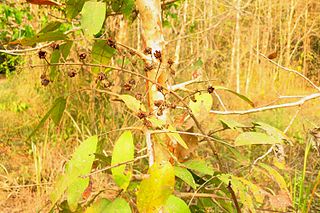
Cratoxylum cochinchinense is a plant now placed in the family Hypericaceae. The specific epithet cochinchinense is from the Latin meaning "of Cochinchina". In Vietnamese C. cochinchinense is usually called thành ngạch nam or lành ngạnh nam, other names include: hoàng ngưu mộc, hoàng ngưu trà and đỏ ngọn.
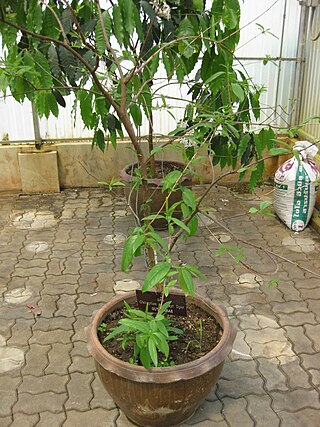
Cratoxylum maingayi is a plant in the family Hypericaceae. It is named for the botanist Alexander Carroll Maingay.
Brackenridgea palustris is a tree in the family Ochnaceae. The specific epithet palustris is from the Latin meaning "swampy", referring to the species' habitat.
Canarium littorale is a tree found in tropical Asia and is a member of the incense tree family Burseraceae. The specific epithet littorale is from the Latin meaning "of the seashore", referring to its habitat.

Eugenia woodburyana is a species of plant in the family Myrtaceae. It is endemic to Puerto Rico. It is a federally listed endangered species of the United States. It is threatened by habitat loss.
Glyptopetalum palawanense is a tree in the family Celastraceae. The specific epithet palawanense refers to the species being native to the island of Palawan in the Philippines.
Mastixia macrocarpa is a tree in the family Nyssaceae. The specific epithet macrocarpa is from the Greek meaning "large fruit".
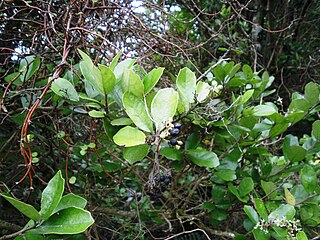
Pennantia corymbosa, commonly known as kaikomako, is a small dioecious forest tree of New Zealand.

Cinnamomum mercadoi (kalingag) is a small tree, about 6 to 10 metres high, with a thick, aromatic bark. The plant part of the family Lauraceae, which contains about 45 genera and 2000-2500 species, and is related to the culinary cinnamon, sassafras, and bay tree. The plant is indigenous to the Philippines, where it grows best in forests at low and medium altitudes that sometimes ascend to 2,000 metres (6,600 ft). C. mercadoi is unusual in the cinnamon family in that its essential oil consists large amounts of safrol, whereas other oils of cinnamon contain cinnamaldehyde. It is currently listed in the International Union for Conservation of Nature (IUCN) Red List as "vulnerable" due to the overharvesting and the continuous loss of the Philippine forests.
Symplocos anomala is a plant in the family Symplocaceae.
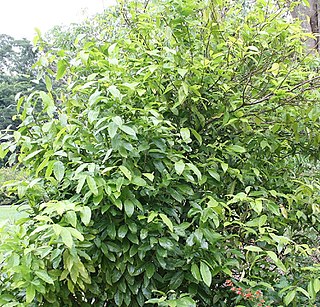
Phaleria perrottetiana is a plant in the family Thymelaeaceae.

Pterophylla fraxinea, formerly known as Weinmannia fraxinea, is a tree in the family Cunoniaceae. It grows up to 40 metres (130 ft) tall. The bark is grey to dark brown. Inflorescences bear up to three pairs of flowers. The specific epithet fraxinea is from the Latin meaning "ash tree", referring to the leaves' resemblance to those of the genus Fraxinus.
Dysoxylum alliaceum is a tree in the family Meliaceae. The specific epithet alliaceum is from the Latin meaning "onion-like", referring to the smell of the inner bark.
Deplanchea bancana is a tree in the family Bignoniaceae. It is named for Sumatra's Bangka Island.
Dacryodes costata is a tree in the family Burseraceae. The specific epithet costata is from the Latin meaning "ribbed", likely referring to the prominent veins on the leaf underside.
Dacryodes laxa is a tree in the family Burseraceae. The specific epithet laxa is from the Latin meaning "loose", referring to the inflorescence.

Dacryodes rostrata is a tree in the family Burseraceae. The specific epithet rostrata is from the Latin meaning "beaked", referring to the narrow-tipped leaves.
Connarus agamae is a tree in the family Connaraceae. It is named for José Agama, a former Deputy Conservator of Forests in British North Borneo.
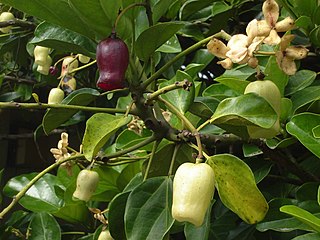
Atuna excelsa subsp. racemosa, synonym Atuna racemosa, is a tree in the family Chrysobalanaceae. The epithet racemosa is from the Latin meaning "clustered", referring to the inflorescence. The tree is widely known as tabon-tabon in the Philippines, where the fruits have been traditionally used for the preparation of kinilaw for almost a thousand years.











